(surgery on 9/16/02)
![]()

(Read
a personal
description of Backblaze here.)
Snoring (and sleep apnea) come from a small airway with loose tissue in the throat flapping around as you breathe. The solution is a straight-forward concept: make the airway bigger and remove loose tissue. Dr. Riley performed 3 procedures on me that can loosely be described as opening the top, sides, and bottom of my airway:
Because of the invasiveness of this surgery, I spent the night in the hospital so they could monitor me. Below is a diagram of a mouth and throat and where everything is located, notice the Tonsils and Uvula:
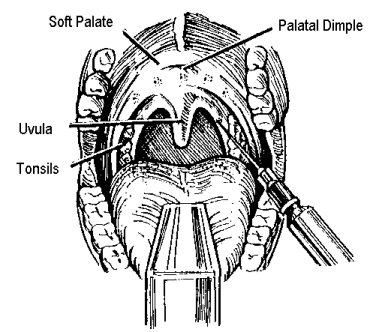
Below is a picture of my (Brian's) original uvula, before the UPPP surgery:

Brian's uvula (or lack there-of) one week post-op, the stitches have not fallen out yet (the stitches eventually dissolve and fall out on their own):

The third procedure Dr. Riley performed was the Genioglossus Tongue Advancement. The genioglossus is the main tongue muscle, which holds the tongue forward. During sleep, this muscle relaxes and often allows the tongue to fall backwards into the airway. This muscle attaches to the inside of your lower jaw to a tiny projection of bone the size of your little fingernail. In this procedure, this bone is broken free, inserted through a small hole made in your jaw, and a small screw holds it until it is healed (the screw can be removed 2 months later).
Front and side diagrams:
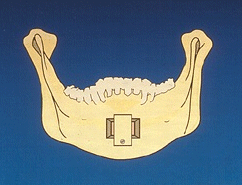
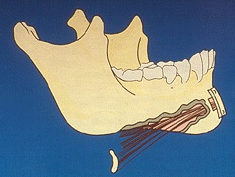
Below are a before and after X-Ray of my chin, showing the screw in my chin, click on the image to get a much larger version:
Pre: Post:
Click here (for pre surgery) and here (for post-surgery) for absolutely humongous total head X-Rays.
Many people ask me questions about recovery like "did it hurt?" and "how long did it hurt?" So this is a quick run down of the surgery experience and recovery. The summary is that it really isn't that bad, but it did hurt to swallow for about a week.
The day of surgery: I arrived at the hospital as instructed about 3 hours before the surgery. To be honest, this is a total waste of time, and is for the convenience of the surgeon, and to make sure that even if you are 2 hours late you still will be ready the moment the surgeon walks in. I took a book along, and did a lot of reading. Along the way I did 5 minutes of "signing in" paperwork, got dressed in a gown for surgery, the anesthesiologist put in an IV, and I hung out the other 2 hours and 50 minutes in a rolling bed. At the appointed time of 1pm, Dr. Riley walked in, said hello, they rolled me into surgery, and they hit me with the general anesthesia. The next moment I woke up in the recovery room with the procedure finished.
The first 30 minutes of recovery: The only really bad part of getting this surgery was the first 30 minutes after waking up. I woke up in recovery in a hellish amount of pain. I look up, and can barely talk (and talking caused so much more pain I wanted to cry), and tell the nurse I'm in pain. If you haven't ever been through something like this, here's how it goes: the nurse asks you to "rate" the pain from 1 - 10, and your answer should ALWAYS be "10", don't even give it a second thought. With an answer of "10", they still only give you about a "3" worth of pain medication anyway. So the nurse asks this question, I choked out "10". Frankly, I think hospitals just SUCK at the way they treat patients, and especially suck at pain management. It took them about 30 minutes of asking me over and over to "rate my pain", me saying "10", and them giving me more medicine, and finally after about 4 iterations I stopped wanting to die to make the pain stop, and the world came into focus and I could think straight again. After that, they kept me comfortable without much prompting.
The first 24 Hours: I spent that night in the hospital with an IV attached to my arm. That was important because I didn't need to drink any water or eat, because the IV had fluids and some sugar in it. The next morning they took out the IV and I started working on swallowing juices and water, and it was uncomfortable but really not that bad. When I swallow, it feels like a little fluid stays in my upper throat, but it's not painful, just annoying. Talking hurt after 10 or 11 words, so basic communication was easy and painless, but any extended conversations were hard. My voice sounded normal immediately, except for talking through some numbness around my front lower lip. Dr. Riley checked in on me twice during this time to look at my throat and make sure everything was Ok.
The first 5 days: My surgery was on a Monday, and I returned to work for a half day on Friday. The rest of the time I hung out at home, taking liquid vicodin (common prescription painkiller) for any pain, which there wasn't much of. I was basically very comfortable during this time, except while eating or swallowing water which hurt a little. By Friday I could eat most normal foods, but I didn't like biting down hard through anything thick because it pushed against the stitches in my jaw below my front teeth and hurt. By Friday, I can talk for about 5 or 10 minute stretches, but then my throat starts really hurting and I have to stop.
Two weeks post op: At two weeks post-op, I consider everything fully healed. I've been off any pain medication for the last few days, I can talk for as long as I like without any pain, eating and drinking are painless, and most of the time I don't even notice or think about my throat or jaw. If I think about it, my jaw and mainly my front two lower teeth are a little numb (Dr. Riley warned me they would be for up to a month), and the back of my throat is just a little scratchy when I swallow. Also, when I bite down, my lower jaw is "tight", I can feel the tension of the tongue advancement against my lower jaw. It's totally painless, just kind of interesting. The doctor says this lasts for a while, then goes away. But life has returned to normal, with the exception that I don't snore at all anymore.
UPDATE 1 YEAR POST-OP (8/3/2003): Now it has been about a year since the surgery, and I wanted to summarize the "final" results. My snoring is completely gone now, although people who sleep in the same room as me describe me as sometimes "trying to snore, but it isn't possible for me". These same people say it isn't annoying at all like my old chain-saw, rip-a-hole-in-reality-type snoring, so I'm very VERY happy with the results. I feel safe and relaxed to fall asleep on airplanes and not annoy everyone in the plane now. :-) Also, getting out of bed in the morning is AMAZING, I wake up without an alarm clock some days after 8 hours of sleep and feel completely refreshed, and hop out of bed happy to head off to work. This is totally different than before when I was a zombie in the mornings even after 10 hours of sleep. It's clear my sleep apnea was really affecting me much more than I (or even my doctors) assumed it was. I'm so happy I did this, it changed my life and happiness so much for the better!
The negatives: the gums directly below my front two bottom teeth are a little numb, and I assume they will be for the rest of my life. I don't notice at all normally, and they have gotten much more feeling since the surgery, but when I press on them with my finger they aren't as sensitive as the gums just a tooth and a half to either side. My lower lip has full feeling, no numbness at all, just the gums. Not that big of a deal. Also, if I think about it or suck my lower up into my mouth, it feels like there is a little wad of cotton tucked into my front lower lip. If you have ever chewed tobacco, or put a small piece of chewing gum in front of your lower front two teeth, it's kind of like that. I've read other people's experiences of this same procedure saying they find this really annoying, but honestly, I don't notice at all day to day, it's just at times like writing this web page and I think about it and play with my lower lip that I notice. It isn't annoying, just a little tiny bit "different" than normal. The chip of bone that was moved is much lower than where it feels like I have a wad of cotton, so I'm assuming this is part of the same numbness side effect -> it isn't that there is a mass there, it is that my gums don't notice the pressure of the lower lip so my brain interprets this as "something is there".
For me personally, if I had to do it all over again, I would ABSOLUTELY do it again, and I'd do it 10 years earlier. The small side effects are tiny price to pay for how fabulous I feel after a night's sleep, and for not annoying someone sleeping in the same room as me. I am profoundly happy with the tradeoff between the positive results and the small side effects. But if you are considering this type of procedure, you should be aware that there are permanent side effects that will probably be with you for the rest of your life.
There are variations on these surgeries. I had the surgeries that Dr. Riley recommended and that he prefers. But there are alternatives to the UPPP and the Genioglossus Tongue Advancement. Below is a quick mention of some of the alternatives.
The common alternative to UPPP is LAUP (Laser Assisted Uvulopalatoplasty). In LAUP, the doctor hits the Uvula and sides of the throat with a laser which scars and tightens the tissue wherever the laser hits. LAUP is commonly done 3 - 5 times spread out over a few months time, each time reducing snoring more and more. LAUP is an extremely common anti-snoring procedure nowadays, and is much more common than UPPP because it is less invasive, less painful for the patient, usually does not involve any stitches or scalpels, and has less chances of things going wrong. The only disadvantage is that it might take a year and 5 treatments to achieve the same results as a single UPPP procedure achieves. Below is a picture of my friend's throat after his 1st LAUP procedure (he eventually had this done 3 times):
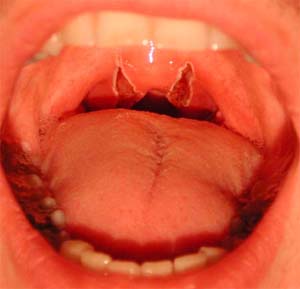
One common problem that causes snoring and sleep apnea for many people (including me) is that the base of the tongue is too large, and falls back and obstructs the airway. The procedure I had done was the genioglossus tongue advancement, but there are several alternatives to achieve the same result.
Tongue Base Radio-frequency Tissue Ablation (Somnoplasty) - To reduce the size of the back of the tongue, radio-frequency treatments may be performed to make it smaller. This simple doctor's office procedure only takes a few minutes, and the doctor puts a needle into the tongue tissue that is too large and "burns" a small area inside (not on the surface). Over the next few weeks that burned area is absorbed by your body, making the tissue smaller and firmer. Below is an animation of the procedure.
Tongue Base Somnoplasty: 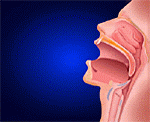
This procedure is repeated several times over a few months. It is a safe and minimally invasive procedure, but it will not always be enough reduction to stop sleep apnea or snoring. In other words, it is a great procedure for the subset of patients for which it works, but it doesn't work for all patients.
Tongue Suspension (or Repose Tongue Stabilization) - This is an older procedure that has been around longer than the genioglossus tongue advancement but does almost the identical thing. A titanium screw is screwed into the inside front floor of the patient's jaw, and a loop of nylon goes from this screw back around the base of the tongue (under the surface of the tongue). This loop of nylon prevents the tongue from "falling back" to obstruct the airway when the patient falls asleep. This procedure bothers me on an emotional level, because for the rest of your life you have screws and nylon embedded in your head. But this is just my irrational emotional reaction.

(Read
a personal
description of Backblaze here.)
![]()